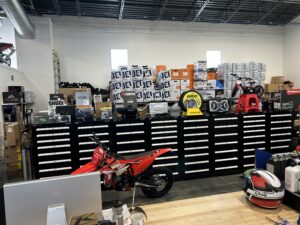Recognizing the Important Parts of a Bike: A Comprehensive Guide for Lovers
For motorcycle lovers looking to raise their riding experience and guarantee their bikes run efficiently, comprehending the important elements of a motorbike is paramount. Each component, from the engine's intricate workings to the important role of the stopping systems, not only affects efficiency however likewise security and comfort.
Engine Parts

The camshaft plays an important duty in regulating the timing of the engine's valves, ensuring the exact opening and closing needed for reliable gas and air intake, in addition to exhaust expulsion. This timing is critical to keeping ideal engine efficiency and efficiency. Furthermore, the carburetor or fuel shot system, depending on the bike design, is in charge of blending air with gas in the appropriate proportion for burning.
The air conditioning system, either air or liquid-based, functions to keep the engine's temperature within functional limits, protecting against getting too hot and ensuring durability - motox parts nz. Each element, thoroughly made and incorporated, adds to the smooth procedure of the engine, specifying the bike's power output and total efficiency
Transmission System
Integral to the motorbike's functionality, the transmission system makes sure efficient power transfer from the engine to the wheels. This system consists of several vital elements, consisting of the clutch, transmission, and last drive, each playing a crucial duty in equating the engine's power right into movement. The clutch, typically run by a hand lever, serves to disengage the engine and involve from the transmission, enabling for smooth equipment modifications and regulated velocity.
The transmission, commonly described as the transmission appropriate, consists of a set of equipments that cyclists can manually change via to adjust the bike's rate and torque result. These equipments are set up in a sequence that makes it possible for the motorcycle to accelerate smoothly and preserve optimum engine efficiency throughout different rates. Many bikes utilize a consecutive gearbox, calling for the cyclist to change equipments in a predetermined order.
Braking Mechanisms
While comprehending the transmission system is key to taking advantage of a bike's power, just as crucial is the capability to control and quit that power properly, which is where stopping mechanisms enter play. Brakes are crucial for safety and security and efficiency, offering the biker with the required control to browse different terrains and problems. Generally, motorcycles include two sorts of braking systems: disc brakes and drum brakes.
Disc brakes are a lot more common in modern bikes as a result of their premium performance. They are composed of a brake disc, caliper, and pads. When triggered, the caliper squeezes the brake pads against the spinning disc, transforming kinetic energy right into warm, thereby reducing the wheel. This system offers much better heat find more info dissipation, regular performance, and boosted quiting power, particularly in damp conditions.
Alternatively, drum brakes, though much less typical, are still located in some motorcycles. They function by pressing brake shoes against the inner surface area of a drum connected to the wheel. While usually less effective in heat dissipation and quiting power, drum brakes are simpler and a lot more affordable.
Recognizing these braking systems' nuances enables cyclists to maintain their motorcycles effectively and appreciate the engineering that ensures secure and reliable quiting.
Suspension and Guiding
Suspension and steering systems are essential elements that significantly influence a motorcycle's handling and trip comfort. The suspension system, containing forks at the front and shock absorbers at the rear, takes in road abnormalities, boosting security and control. Front forks, generally telescopic or upside down, compress and rebound to reduce impacts, while rear shock absorbers preserve tire contact with the road, important for traction and safety and security.
Guiding, focused around the handlebars, links the rider to the motorcycle's directional control. The steering head bearings ensure smooth operation, allowing accurate ability to move. Appropriate alignment and maintenance of these bearings are important for predictable steering reaction and decreasing biker tiredness.
The suspension's adjustability is one more crucial aspect; preload, damping, and rebound settings allow modification to match different riding styles and problems. This flexibility is necessary for enhancing efficiency, whether navigating city roads or dealing with tough trails. Technologies like digital suspension systems provide real-time adjustments, boosting experience quality across varied terrains.

Electrical Equipments
After making certain a controlled and smooth adventure through reliable suspension and guiding systems, attention transforms to the electric systems, an essential facet of contemporary motorcycles. These systems play a critical role not just in beginning the engine but likewise in powering numerous components that improve the functionality and safety and security of the motorcycle.
At the heart of a motorbike's electric system great site is the battery, which shops electric energy required for beginning the engine and powering supporting systems - motocross parts nz. The generator or generator, coupled with motorcycle supply the rectifier-regulator, ensures the battery remains billed while the motorbike functions, transforming mechanical power into electric power and keeping voltage degrees
The ignition system, another vital part, is accountable for firing up the air-fuel combination in the engine's cylinders. Modern motorbikes commonly make use of an electronic ignition system, using better efficiency and reliability compared to traditional systems.
Illumination systems, including fronts lights, tail lights, and indications, are likewise important, making sure exposure and safety for the motorcyclist. Extra digital elements such as sensing units, control units, and presents add to sophisticated functions like gas injection management, anti-lock braking systems (ABS), and digital control panels, additionally boosting the riding experience.
Verdict
A thorough understanding of a motorbike's necessary elements, including the engine, transmission system, stopping systems, suspension, steering, and electric systems, is vital for lovers aiming to maximize comfort, safety and security, and efficiency. Mastery of these components enables educated decisions concerning upkeep and upgrades, eventually boosting the riding experience. By integrating this expertise, cyclists can ensure their motorbikes operate at peak effectiveness and reliability, therefore making the most of both satisfaction and longevity of their automobiles.
For motorcycle fanatics looking to elevate their riding experience and ensure their bikes run efficiently, comprehending the vital parts of a motorcycle is vital.Indispensable to the motorbike's capability, the transmission system guarantees effective power transfer from the engine to the wheels.While recognizing the transmission system is essential to harnessing a motorcycle's power, similarly crucial is the capacity to control and quit that power effectively, which is where braking systems come into play. Typically, bikes feature two types of stopping systems: disc brakes and drum brakes.
An extensive understanding of a motorbike's crucial components, consisting of the engine, transmission system, stopping systems, suspension, guiding, and electric systems, is indispensable for lovers aiming to enhance safety, comfort, and performance.
 Jennifer Grey Then & Now!
Jennifer Grey Then & Now! Patrick Renna Then & Now!
Patrick Renna Then & Now! Jenna Jameson Then & Now!
Jenna Jameson Then & Now! Robbie Rist Then & Now!
Robbie Rist Then & Now! Rossy de Palma Then & Now!
Rossy de Palma Then & Now!